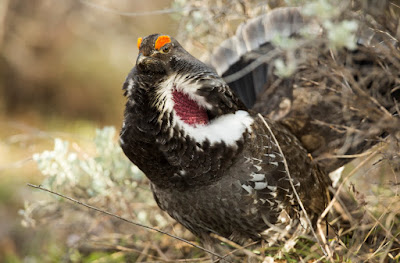Colorado Chicken Run
I have recently returned from a birding trip to Colorado
where our goal was to observe prairie chickens and grouse on their leks. What exactly is a lek you might legitimately
inquire? A lek is defined as “an
aggregation of males that gather to engage in competitive displays that may
entice visiting females who are surveying prospective partners for
copulation.” This is an annual mating
ritual for these birds and they return to the same lek grounds each spring and
have done so for many generations. To see
these activities one must rise early and head out to the lek at 4:30 AM. Once there you must remain in a blind of some
sort and be very quiet so as not to frighten them off or disturb their
activities. These birds do a dance of
foot stopping, inflate various air sacs on their necks or breast and offer
various vocalizations to entice the nearby females. They frequently indulge in confronting
another male in the lek and attempt to drive him off by intimidation, such as,
getting down low and meeting the other face to face which is generally followed
by some form of leaping into the air much as you would see in a more familiar
domestic rooster fight. Fortunate for us
we were able to visit five active leks and see all preform their ritual--the
five include Lesser and Greater Prairie Chicken, Greater and Gunnison Sage
Grouse, Sharp-tailed Grouse and a very cooperative Dusky Grouse all of which I
have provided pictures of for this article (except the Gunnison Sage-Grouse
much too far away).
In addition to the above game birds, we were also fortunate
to observe four others—Ring-necked Pheasant, White-tailed Ptarmigan, Rio Grande
Turkey and Chucker. Of these four the
White-tailed Ptarmigan is a very difficult species to add to one’s life list,
primarily because it resides at high elevations. We were fortunate to observe four of them at
Loveland Pass near Dillon. The four were
foraging on a grass outcropping from the deep snow found there even at this
late date. The bird is all white at this
stage of the year but will soon molt into its summer plumage which features a
mottled dark brown coloration. I was not
able to get pictures of sufficient quality of the White-tailed Ptarmigan to i
in include in this article. However, the
Chucker was very cooperative and posed for his photo. This bird is generally found at lower
altitudes. We located our bird at Coal
Canon near Cameo, CO. This species is an
introduced resident of the Great Basin.
It prefers arid rocky slopes and cliffs near water. It is found in desert shrub, pinyon-juniper
and montane brush habitats. Its call
begins with a slow Chuka, Chucka and ends
with a strong ChuKARA , thus sounding as if it is calling it name.
I will conclude by saying that this was a very successful
trip even though we experienced snow ever day but our first and last day on
this eleven day outing. In all we drove
over 2000 miles to accomplish our mission.
In addition, our bird list totaled over 160 species which included many
other target birds. In fact, we only
missed one of our target species for this trip—Williamson’s Sapsucker.
Finally, on May 16th I off to drive and spend the
summer in Alaska. I will have the
opportunity to re-visit many places I have been on fourteen previous trips to
this amazing state and will spend some time exploring regions in Canada I have
not previously visited. I plan to write
a blog of my travels and experiences along the way and will be contributing
articles to the Sun about those
adventures. If you would like to follow me on my blog simply go to www.irasciblej-alongthetrail.blogspot.com
and join and you will automatically receive each blog as it is posted. There may be times when the internet is not
available and I will not be able to post them, so please be patient. I hope you all have a very cool and wet
summer back here in Texas, I know I will enjoy cool and beautiful Alaska.
Jim—irasciblej@gmail.com
 |
| Chucker |
 |
| Sharp-tailed Grouse |
 |
| Dusky Grouse |
 |
| Lesser Prairie Grouse |
 |
| Greater Prairie Chicken |
 | |
| Greater Sage-Grouse |
No comments:
Post a Comment